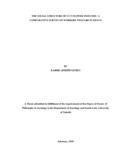| dc.description.abstract | As suggested in the title “The social structure of cut flower industry: A comparative survey of workers‟ welfare in Kenya”, this study focuses on the welfare of workers in the cut flower industry. The study pays special attention to mechanisms that exist to cushion the workers‟ welfare in the cut flower industry. Specifically, the study looks into the issue of wages and whether or not such wages are commensurate with the workers‟ efforts within the context of the productive relations. The study also looks into attendant impacts of the state and non-state actors on the workers‟ welfare. Further, the study explores the ownership of the cut flower by Multinational Companies (MNCs) as well as the local capital ownership and how these influence the mode of production with regard to the workers‟ welfare dynamics. An additional dimension of the study focus has to do with the certification of cut flower farms by local and international agencies and how they also relate to the overall exchange dynamics and outcomes.
To achieve the aim of this study, a comparative survey of 358 workers was conducted in three cut flower regions in Kenya - Naivasha, Nanyuki, and Thika. The major data collection techniques and instruments included survey, personal interviews guided by a questionnaire, key informants interviews based on an unstructured guideline for key informants and focus group discussions guided by group discussion guide, all following an extensive literature review. The data collected was processed using the Statistical Package for Social Science (SPSS) and Stata statistical programmes. Thereafter, the data was analyzed progressively at the univariate, bivariate and multivariate levels.
Key findings of the study show that workers in the cut flower industry were literate and skilled, this study established that almost half of the workers (48.9%) had attained secondary education and that at least 40% had technical skills, which to a large extent were not relevant to their work. Almost 70% of the workers were employed on permanent basis, though with low retention rate; almost 60% had been engaged in employment for a period of less than four years and majority (82.4%) worked for eight hours a day. The typical low cadre workers earned an average wage of KShs. 8,600, slightly lower than the government legislated minimum wages in the general sector (KShs. 10,954) and the computed living wage (KShs. 18, 000-KShs. 21, 545). The workers in cut flower industry are thus part of the working poor in the country. Surprisingly, (81%) of the sampled did not engage in other income generating activities.
At the bivariate level of analysis, a cross-tabulation of ownership of the farm and workers‟ wages showed that the locally owned farms paid better wages than farms owned by the MNCs. A cross tabulation involving the status of certification of a farm showed that 36% of the workers perceived that their working conditions as “at least poor” in non-certified farms were five times higher than the percentage of workers (7.2%) in the certified farms. Certification thus, tends to enhance workers‟ welfare. Correlation was also undertaken regarding the study‟s dependent variable (workers‟ welfare) and each of the selected independent variables. The state effectiveness in enhancing workers welfare was found to have the highest influence with a modest value of r = +0.46. The findings of this study thus affirm that workers‟ wages enhance their welfare though moderately at r = +0.35. At the multivariate level of analysis, the study measured the individual and combined effects of the study‟s five independent variables on the study‟s dependent variable (workers‟ welfare) using probit regression. Among all the five factors/regressors the best one in determining workers‟ welfare was the state effectiveness. Indeed, a unit change on state effectiveness, leads to a probability of change on workers‟ wellbeing by 33%. Further, the probability of workers being better off from a unit increase with certification of a cut flower farm improves by 27%. Surprisingly, a unit increase of trade union effectiveness decreases the probability of higher welfare by almost 10%. The study in conclusion, observes that at an average wage of KShs. 8,600, the workers in the cut flower industry are part of the working poor in Kenya. Regarding the findings that at least 9% of the workers in the cut flower farms were paid wages that were lower than the legislated minimum wages, the recommendation also called on the state through its oversight role to ensure that labour policies are strictly adhered to. | en_US |



